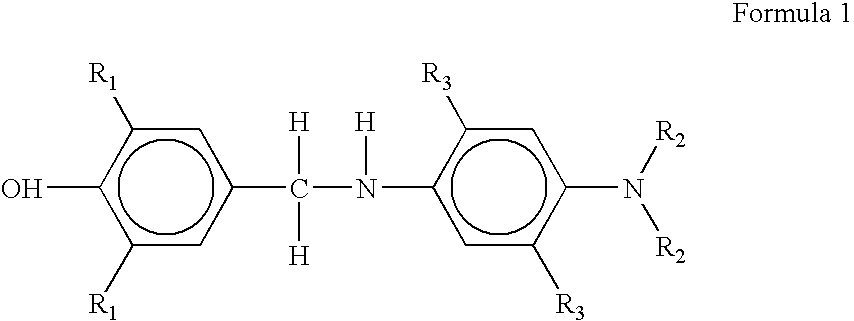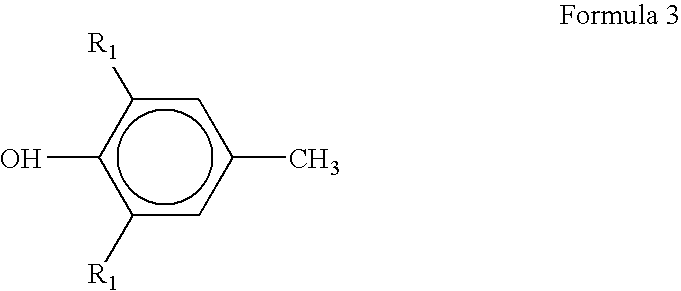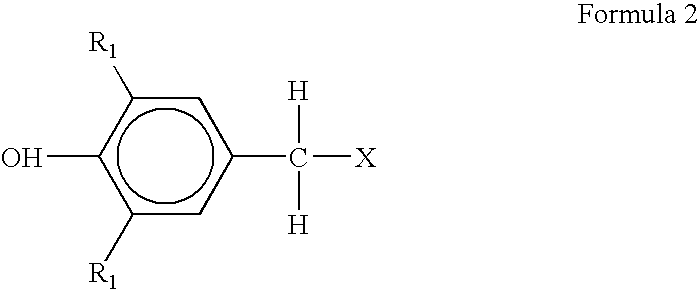Antiozonant cum antioxidant, process for preparation
a technology of antioxidant and ozonant cum, applied in the field of antiozonant cum antioxidant, process for preparation, can solve the problems of common use, deterioration of these polymeric materials, loss of molecular weight and macroscopic physical properties, etc., and achieve the effect of achieving thermal stability of various other polymers
- Summary
- Abstract
- Description
- Claims
- Application Information
AI Technical Summary
Problems solved by technology
Method used
Image
Examples
example 2
Synthesis of 4-[(4-Amino-phenylamino)-methyl]-2,6-di-tert-butyl-phenol
4-Bromomethyl-2,6-di-tert-butyl-phenol (2.42 g, 0.008 mole) was dissolved in 50 mL of dry tetrahydrofuran. In a separate conical flask benzene-1,4-diamine (p-PDA) (1.728 g, 0.016 mole) was dissolved in 25 mL of tetrahydrofuran and solution was transferred to a cylindrical funnel with pressure equalizing tube. Three-necked round-bottom flask containing solution of 4-Bromomethyl-2,6-di-tert-butyl-phenol was kept in oil-bath at 85.degree. C. Solution in the flask was continuously stirred with the help of magnetic stirrer. Benzene-1,4-diamine solution was added drop-by-drop, from funnel to the flask in acidic medium for a span of 4-5 hours till all the solution was poured out. The reaction was terminated after that and the final reaction mixture was allowed to attain room temperature. The product was purified using silica gel column chromatography. Product was identified by .sup.1 H-NMR. The yield of 4-[(4-Amino-pheny...
example 3
Synthesis of 2,6-di-tert-butyl-4[(4-dimethylamino-phenylamino)-methyl]-phenol
4-Bromomethyl-2,6-di-tert-butyl-phenol (2.42 g, 0.008 mole) was dissolved in 50 mL of dry tetrahydrofuran. In a separate conical flask N,N-dimethyl-benzene-1,4-diamine (2.17 g, 0.016 mole) was dissolved in 25 mL of tetrahydrofuran and solution was transferred to a cylindrical funnel with pressure equalizing tube. Three-necked round-bottom flask containing solution of 4-Bromomethyl-2,6-di-tert-butyl-phenol was kept in oil-bath at 85.degree. C. Solution in the flask was continuously stirred with the help of magnetic stirrer. N, N-dimethyl-para-phenylene diamine solution was added drop-by-drop, from funnel to the flask in acidic medium for a span of 4-5 hours till all the solution was poured out. The reaction was terminated after that and the final reaction mixture was allowed to attain room temperature.
The product was purified using silica gel column chromatography. Product was identified by .sup.1 H-NMR. The...
example 4
Synthesis of 4[(4-Amino-2,5-dimethyl-phenylamino)-2,6-di-tert-butyl-phenol
4-Bromomethyl-2,6-di-tert-butyl-phenol (2.42 g, 0.008 mole) was dissolved in 50 mL of dry tetrahydrofuran. In a separate conical flask 2,5-dimethyl-benzene-1,4-diamine (2.17 g, 0.016 mole) was dissolved in 25 mL of tetrahydrofuran and solution was transferred to a cylindrical funnel with pressure equalizing tube. Three-necked round-bottom flask containing solution of 4-Bromomethyl-2,6-di-tert-butyl-phenol was kept in oil-bath at 85.degree. C. Solution in the flask was continuously stirred with the help of magnetic stirrer. 2,5-dimethyl-para-phenylene diamine solution was added drop-by-drop, from funnel to the flask in acidic medium for a span of 4-5 hours till all the solution was poured out. The reaction was terminated after that and the final reaction mixture was allowed to attain room temperature. Product was separated by solvent evaporation. The product was purified using silica gel column chromatography. ...
PUM
| Property | Measurement | Unit |
|---|---|---|
| temperature | aaaaa | aaaaa |
| temperature | aaaaa | aaaaa |
| pressure | aaaaa | aaaaa |
Abstract
Description
Claims
Application Information
 Login to View More
Login to View More - R&D
- Intellectual Property
- Life Sciences
- Materials
- Tech Scout
- Unparalleled Data Quality
- Higher Quality Content
- 60% Fewer Hallucinations
Browse by: Latest US Patents, China's latest patents, Technical Efficacy Thesaurus, Application Domain, Technology Topic, Popular Technical Reports.
© 2025 PatSnap. All rights reserved.Legal|Privacy policy|Modern Slavery Act Transparency Statement|Sitemap|About US| Contact US: help@patsnap.com



